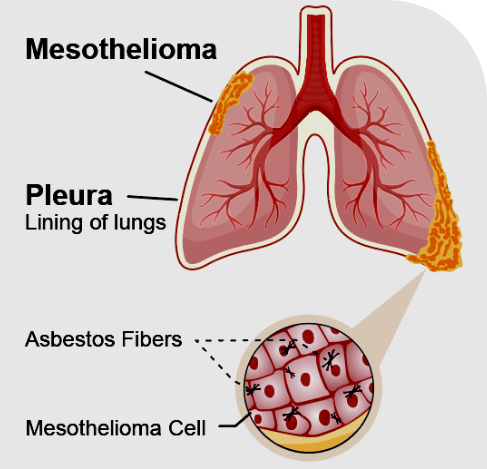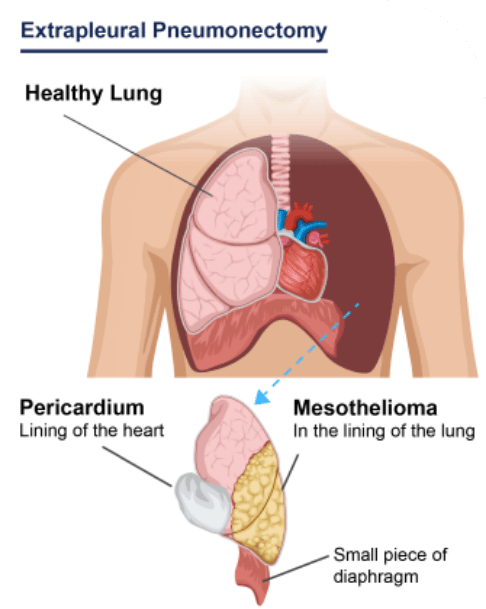Pleural Mesothelioma
Mesothelioma is cancer in the membrane of various organs. Pleural mesothelioma, also called malignant pleural mesothelioma or MPM, is found in the membrane between the lungs and chest wall, called the pleura. Without treatment, the average life expectancy of pleural mesothelioma is six months following diagnosis. Mesothelioma surgery, chemotherapy, radiation therapy, and other treatments can extend life expectancy.
Home » National Mesothelioma Law Firm » Mesothelioma Cancer » Types of Mesothelioma » Pleural Mesothelioma
Pleural mesothelioma, also known as malignant pleural mesothelioma or MPM, is a relatively rare and aggressive type of cancer. It forms in a membrane called the pleura, which is located between the lungs and the chest wall. Asbestos exposure is the only known risk factor for this disease. Life expectancy after diagnosis is generally less than two years, and long-term survival is uncommon, although the medical community hopes that emerging treatments will lead to better outcomes.
Pleural Mesothelioma Risk Factors
The only known risk factor for malignant pleural mesothelioma is exposure to asbestos. This is a mineral that was commonly used for many years in various industrial and military applications because it’s extremely stable and highly heat-resistant. More than 80% of mesothelioma patients have a known history of asbestos exposure.
When a person inhales small particles of asbestos, these become embedded in the lungs. The tiny particles can then migrate through the lung tissue into the surrounding pleura. A strong inflammatory response is triggered by the presence of asbestos. Because asbestos is too stable to be broken down, this response is sustained for years.
Over time, this inflammation can cause scarring in the lungs, which is known as asbestosis. It can also cause damage to the DNA of cells, which may eventually lead to cancer. It can take 20 to 40 years or longer for mesothelioma to develop. While asbestos exposure is most strongly associated with the development of mesothelioma, it also increases the risk of other types of cancer, including lung cancer, which forms in the lung tissue itself rather than in the pleura around the lungs.
People who worked in certain industries where asbestos use was historically common are at the greatest risk for malignant pleural mesothelioma. Unfortunately, companies did not always choose to provide their workers with adequate protection, even after the dangers of asbestos were known. Some of those at high risk include:







In addition, the families of workers may also be at risk. Asbestos fibers can travel on a worker’s clothes, skin, and hair to enter the home and be inhaled by family members.
The use of asbestos is now heavily regulated in the United States, and the incidence of malignant pleural mesothelioma has declined. However, some people are surprised to learn that asbestos is not completely banned in the United States, and asbestos imports are still occurring.
Malignant Pleural Mesothelioma Symptoms
People with pleural mesothelioma cancer may experience a variety of symptoms, including:
- Shortness of breath
- Chest pain
- Difficulty swallowing
- Fever
- Swelling of the face and/or arms
- Dry cough
- Hoarseness of the voice
- Unexplained weight loss
- Night sweats
- Loss of appetite

Similar symptoms can also be caused by a number of other diseases, including pneumonia and other lung infections, COPD (emphysema), asthma, and lung cancer. All of these are more common than mesothelioma, which makes the diagnosis of this disease challenging.
Pleural Mesothelioma Diagnosis
When a patient first visits their doctor with symptoms, the doctor will consider many different possible causes. Often, one of the first steps in the diagnosis is a chest X-ray. If the patient has pleural mesothelioma, this may show the tumor, or it may show an area of pleural thickening or a pleural effusion—fluid buildup around the lungs. However, the specific type of tumor won’t be evident from the X-ray.
Additional imaging studies, such as a computerized tomography (CT) scan, are often used next. A CT scan is more detailed than an X-ray and can show the precise location of the tumor. In some cases, other imaging studies, such as an MRI or a PET scan, are also performed to locate the cancer and determine how far it has spread.
The definitive diagnosis of pleural mesothelioma can be established only by a biopsy, which involves taking out a small piece of the tumor. The sample is sent to a pathologist, who looks at the cells under a microscope and tests them to determine whether they’re cancer cells and, if so, what type.
For patients with malignant pleural mesothelioma, there are a few different ways to obtain a biopsy sample.
- If the tumor is located close to the skin, the biopsy specimen may be obtained using a needle inserted through the skin.
- If the patient has a pleural effusion (fluid buildup around the lungs), a doctor may use a procedure called thoracentesis to drain this fluid. There may be enough cancer cells in the fluid for the pathologist to analyze.
- A thoracoscopy may be used to obtain the sample. In this procedure, a thoracic surgeon makes a small incision in the chest wall and inserts a long flexible tube with a camera and a light on the end, through which surgical instruments can be inserted, into the chest cavity. The surgeon will also look for additional tumors inside of the chest.
Blood tests known as immunochemistry are sometimes used to confirm the diagnosis. These tests look for particular proteins in the blood in order to distinguish different types of cancer from each other.
Pleural Mesothelioma Cell Types
The histology or cell type of mesothelioma is an important prognostic factor and makes a significant difference in a patient’s treatment options. The three cell types are:

- Epithelioid, in which the cells are more regularly shaped and tend to form sheets or clumps. This cell type is the easiest to treat and has the most favorable prognosis. It's also the most common, affecting more than half of pleural mesothelioma patients.
- Sarcomatoid, in which the cells are long and thin and tapered at both ends. This type is the most difficult to treat, and the prognosis is poor.
- Biphasic, which has characteristics that are intermediate between the other two cell types.
Malignant Pleural Mesothelioma Stages
The stage of a cancer refers to how advanced the disease is and is reported as a number from one to four. For malignant pleural mesothelioma, there’s an official system called the TNM staging system for determining the stage.
STAGE-1
Mesothelioma is localized to the pleura.
STAGE-2
STAGE-3
STAGE-4
Unfortunately, many cases of pleural mesothelioma are diagnosed in their later stages. This is because the cancer is fairly aggressive, and the diagnosis is challenging.

Pleural Mesothelioma Life Expectancy
Long-term remission from malignant pleural mesothelioma is unfortunately rare, and malignant pleural mesothelioma is generally considered to be an incurable cancer. Treatments may extend a person’s life but are unlikely to eliminate the cancer entirely. It’s hoped that new treatments will lead to a better prognosis.
Malignant pleural mesothelioma life expectancy is not high for most patients. Without any treatment, a pleural mesothelioma patient can be expected to live an average of six months following diagnosis.
Treatment can extend this time, but life expectancy is limited. Studies have shown median survival rates of about 15 to 22 months, depending on the stage of the cancer at the time of diagnosis. Only 12% of malignant pleural mesothelioma cancer patients survive for five years.
Treatment of Pleural Mesothelioma
The treatment plan for a malignant pleural mesothelioma patient depends on factors including stage and cell type. Most patients receive mesothelioma multimodal therapy, which means using multiple types of treatments.
The management of malignant pleural mesothelioma often involves specialists in various fields, including medical oncology, thoracic surgery and radiation oncology. Many pleural mesothelioma patients are treated at a cancer center to have access to all of the care that they need.
In early stages, doctors may use aggressive treatment to try to eliminate the cancer. In later stages, treatment is often focused on palliative care, which is aimed at improving quality of life rather than longevity.

Surgery for Pleural Mesothelioma
- Extrapleural pneumonectomy (EPP).
- Pleurectomy/decortication (P/D)
This is a slightly less invasive procedure. The surgeon removes the pleura on the affected side, along with any apparent tumors. Pleurectomy/decortication carries a lower risk than extrapleural pneumonectomy, and some studies have shown that it’s equally effective at improving patient survival, although more research is needed.
There are also surgical procedures used specifically for palliative care. For example, the fluid buildup of a pleural effusion makes it difficult to breathe. This can be relieved through thoracentesis, a procedure in which a doctor inserts a tube through the chest wall and drains the excess fluid.
Pleurodesis, which is a procedure that attaches the two layers of the pleura to prevent fluid buildup, may help those who experience repeated pleural effusions.

Chemotherapy
Many pleural mesothelioma cancer patients receive chemotherapy through an IV. This method delivers the medication to the whole body, which can help to destroy any cancer cells that have migrated away from the original tumor. In most cases, chemotherapy involves a combination of pemetrexed with either cisplatin or carboplatin. Studies have shown that chemotherapy can significantly improve survival, though it does cause significant side effects.
Another method is called heated intrathoracic chemotherapy. This method is similar to the Sugarbaker treatment, which has been successfully used for peritoneal mesothelioma—found in the abdomen—for years.
The thoracic surgeon first removes as much of the cancer as possible. Next, a warmed solution of chemotherapy drugs, most commonly cisplatin, is infused into the chest cavity, left for a period of time, and then washed out. This delivers the chemotherapy drugs directly to the sites where cancer cells are most likely to be and reduces the likelihood and severity of side effects.

Radiation Therapy
Radiation therapy, also known as radiotherapy, is often used after surgery to minimize the chance that the tumor will regrow. The most commonly used type of radiation therapy is external beam radiation therapy. Multiple weaker beams of radiation are aimed at the tumor from different angles. The beams cross at the site of the tumor, delivering a higher dose of radiation to that area. The surrounding areas receive less radiation, which helps to reduce side effects.

Immunotherapy
Immunotherapy is the newest treatment option for pleural mesothelioma. The treatment stimulates the patient’s immune system, causing it to destroy the cancer cells. Two forms of immunotherapy are now FDA-approved for treating malignant pleural mesothelioma, and more are currently under development.

Clinical Trials for Pleural Mesothelioma
Although malignant pleural mesothelioma is currently considered incurable, researchers are working to discover new ways to treat this disease. Emerging treatment options include gene therapy, photodynamic therapy and new forms of immunotherapy.
Some pleural mesothelioma patients choose to participate in a clinical trial. Clinical trials are research studies of new treatments. The biggest advantage of participating is that you may get access to a cutting-edge treatment that could extend your life.
However, it’s important to consider the tradeoffs. Cancer research studies usually have a control group, so you might not get the experimental treatment. There’s also no guarantee that the new treatment will work better than existing treatments.
If you’re considering this option, the National Cancer Institute has a useful database you can search to find clinical trials for pleural mesothelioma cancer. Often patients must meet certain criteria, such as being at a certain stage, to qualify for a trial. We recommend discussing clinical trials with your oncologist, who can help you weigh the risks and benefits and determine which trials you’re eligible for.
By submitting this form, you agree to our terms & conditions. Please read full disclaimer here.



